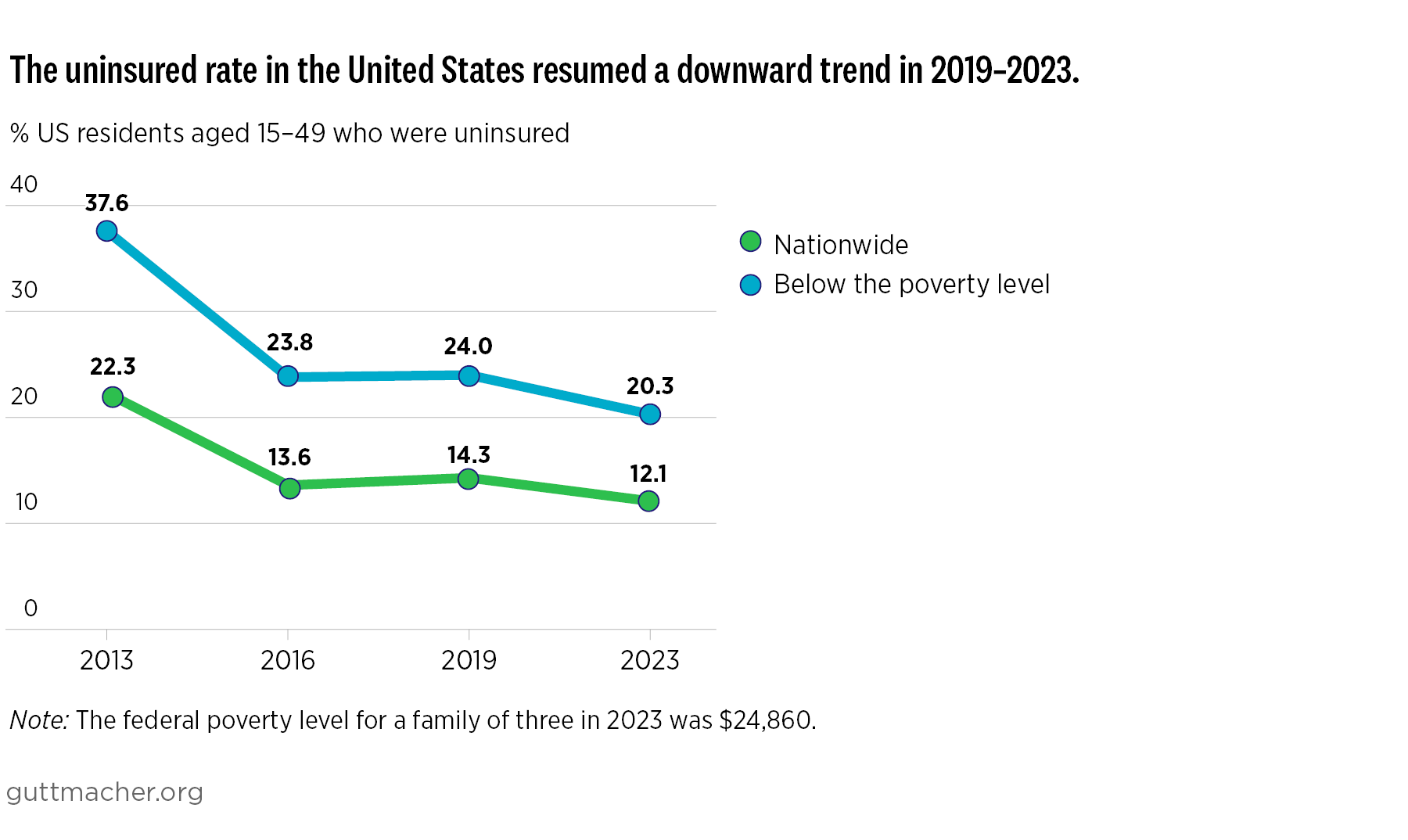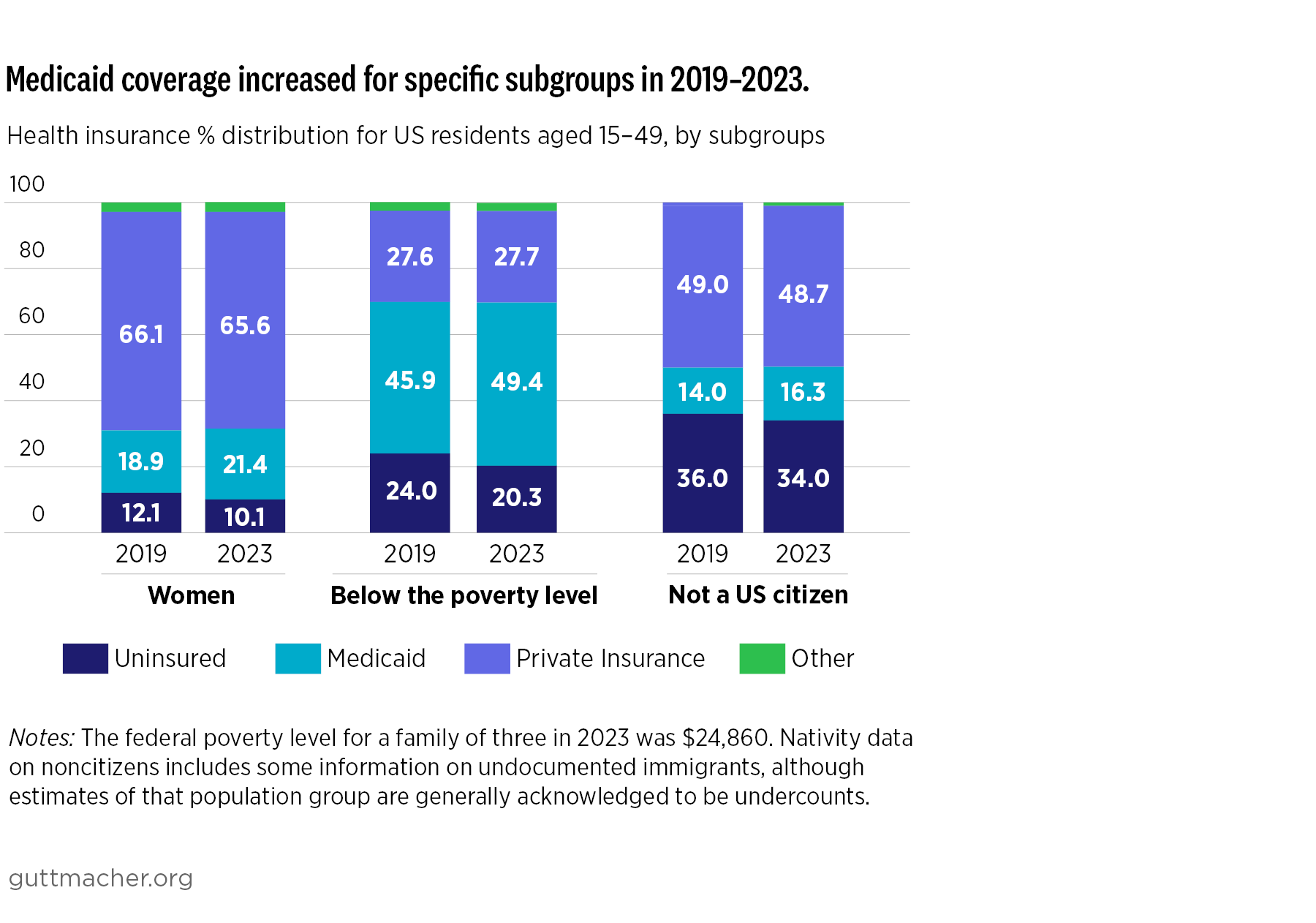Between 2019 and 2023, the United States saw a substantial increase in the number of people insured through Medicaid, leading to a decrease in the overall rate of uninsured people of reproductive age (15–49). This positive development represents the lowest ever uninsured rate for this portion of the US population—and, in fact, 2023 marked the lowest ever uninsured rate for the population in general. These data suggest that an increasing number of people were able to access health care, including critical sexual and reproductive health services.
Since the Affordable Care Act (ACA) was enacted in 2010 and implemented in 2014, the number of people without health insurance has dropped substantially and remained much lower than pre-2014 levels. However, after falling sharply between 2013 and 2016, the proportion of people of reproductive age without health insurance increased slightly between 2016 and 2019, due in part to policies that stymied access to health coverage during the first Trump administration. Since then, the percentage who are uninsured resumed a slow decline through 2023, supported by Biden-era policies that expanded access to health insurance and protected existing coverage during the period of the COVID public health emergency. (See figure.)
Health insurance coverage is critical to addressing cost barriers that otherwise prevent people from accessing health care and realizing their sexual and reproductive health and rights. In particular, state and federal policies that expand access to Medicaid and ensure full coverage of contraception, STI testing and treatment, cancer screenings and more help ensure that people with low incomes have access to care. Unfortunately, policymakers are currently threatening to restrict health care access through measures that could dramatically cut Medicaid and decrease subsidies that support access to private plans under the ACA. If enacted, these policies would set back years of progress and bring particular harm to communities and individuals already facing multiple barriers to health care, including Black and other people of color, immigrants and those with low incomes.
Progress Resumed
According to Guttmacher Institute analysis of the most recent government data,* between 2019 and 2023, the proportion of all people of reproductive age who were uninsured fell two percentage points (from 14% to 12%), and it fell for women of reproductive age (from 12% to 10%). Unfortunately, one in five people living below the federal poverty line remains uninsured—yet there was a significant decline in the proportion uninsured among this group during this time period (from 24% to 20%).
While the proportion of people of reproductive age with private insurance remained largely unchanged between 2019 and 2023, there was a 2.5 percentage point increase in the proportion enrolled in Medicaid. This shift reflects a broader pattern at the national level, in which the proportion of people with private insurance held relatively steady and the drop in the proportion without insurance was mirrored by an increase in the proportion covered by Medicaid. Similar patterns are evident across a range of categories, including women, non-US citizens, and people of all race and ethnicities. (See attached background tables for more information.)
Considering the entire decade from 2013 to 2023, women have made historic gains in health insurance coverage, with the proportion uninsured falling by half: for all women aged 15–49 years it fell from 19.5% to 10.1% and for such women with incomes below the poverty level from 34.5% to 18.0%. These gains are due to increases both in private insurance (mainly during the first half of the time period) and in Medicaid coverage. For all women of reproductive age, the proportion covered by private insurance rose from 61.8% in 2013 to 65.6% in 2023 and for women with incomes below poverty from 22.5% in 2013 to 27.1% in 2023. The proportions enrolled in Medicaid rose between 2013 and 2023: from 15.7% to 21.4% for all women of reproductive age and from 40.8% to 52.8% for women with incomes below the poverty level.
The ACA’s coverage expansion policies, including the option for states to expand Medicaid eligibility, continues to have a large impact on people’s access to health insurance. While 33 states had adopted Medicaid expansion by 2018, seven new states (Nebraska, Utah, Idaho, Missouri, Oklahoma, South Dakota and North Carolina) expanded Medicaid between 2019 and 2023. Five of these new states (not including South Dakota and North Carolina, which expanded eligibility in the latter part of 2023) experienced relatively large increases in women’s Medicaid coverage during this time period. The 40 states (plus DC) that have expanded Medicaid continue to have much lower uninsured rates compared to the 10 states that have not expanded coverage. (See background tables.)
During the 2019–2023 time period, the COVID-19 pandemic prompted the federal government to enact multiple laws expanding access to private insurance plans available on the ACA marketplace and to protect coverage. The American Rescue Plan Act of 2021 temporarily expanded the ACA marketplace subsidies by removing the income cap for subsidy eligibility and increasing assistance for low-income enrollees. The Inflation Reduction Act of 2022 extended these marketplace subsidies through 2025, helping millions continue to access low or no cost health plans. These federal measures contributed to record high enrollment in the ACA marketplace by 2023. At the same time, the Families First Coronavirus Response Act of 2020 contained a Medicaid continuous enrollment provision that prevented states from disenrolling individuals from Medicaid during the public health emergency, which helped preserve coverage for millions of people during this time. (This provision was terminated in March 2023, however, impacting the insurance status of millions.)
Recommendations
In the face of unprecedented threats to critical health programs, policymakers must resist any attempts to compromise access to health insurance and, in particular, Medicaid and its critical role in sexual and reproductive health. Medicaid covers one in five Americans, making it the nation’s largest single source of health coverage. It ensures children, pregnant individuals, people with disabilities, and other vulnerable populations have access to health care. Over half of low-income women of reproductive age rely on Medicaid. For many, especially Black, Indigenous, and other people of color, Medicaid is the only reliable path to medical care in a system shaped by racism and economic inequality. Any policies aimed at slashing Medicaid funding, whether by limiting eligibility, instituting burdensome work requirements, or changing the funding structure, would strip coverage from eligible people. Leaders must also safeguard the Affordable Care Act (ACA) against proposed rollbacks. Not only has the ACA been instrumental in extending insurance coverage, it has also been especially impactful in expanding access to services such as contraception and maternal care; any effort to undermine the ACA would reverse progress in health access and equity.
In a nation where more than one in 10 adults of reproductive age remain uninsured, policymakers should not only guard against harm, but also proactively explore bold strategies to expand coverage and reach remaining uninsured, as well as the underinsured. More than a decade after the ACA was enacted, 10 states still refuse Medicaid expansion, leaving a coverage gap for millions of individuals with incomes too low for ACA marketplace subsidies. This gap disproportionally affects people of color, highlighting how coverage barriers reinforce systemic inequities. Even for those who are technically insured, underinsurance remains a pervasive problem, as inadequate coverage often fails to protect against high out-of-pocket costs, limits access to care and exacerbates health inequities. Furthermore, policymakers must minimize unnecessary disenrollments and coverage losses and bolster enrollment efforts to ensure that eligible enrollees—whether for Medicaid or private insurance—do not fall through the cracks.
Protecting and restoring policies that helped bring down the uninsured rate in recent years, including expanded access to Medicaid and the ACA marketplace, should be a top priority for policymakers. In a time of rising health care costs and restrictions on bodily autonomy, insurance coverage remains critical to advancing health care access and health equity, as well as sexual and reproductive health.

